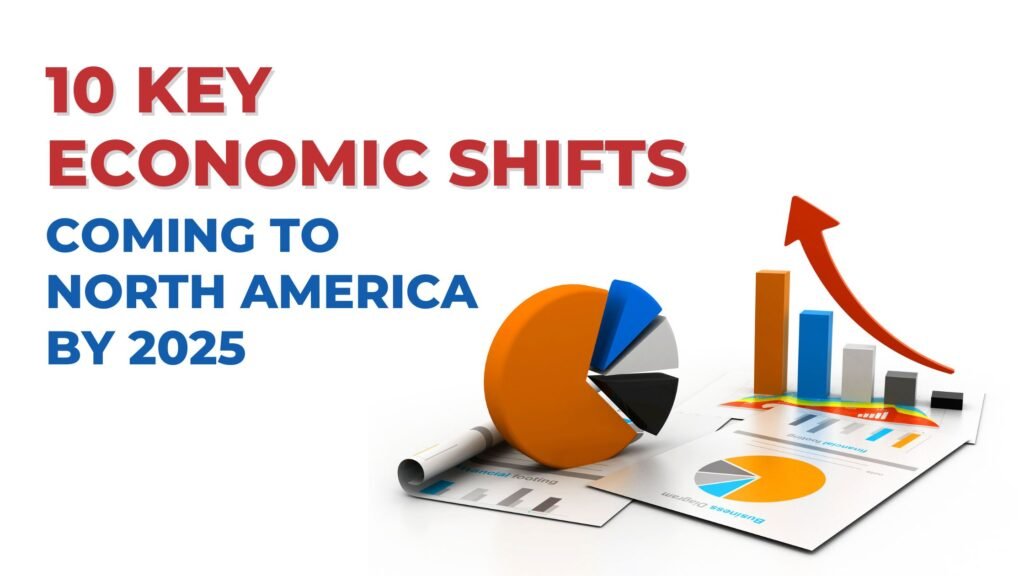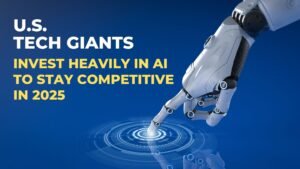The economic landscape in North America is undergoing transformation through rapid changes in technology, consumers’ behavior, and market dynamics. By 2025, the following are ten important trends that will change the way of the economy: impacts that businesses, policymakers, and consumers need to keep a close watch on.
1. Integration of AI in Digital Transformation
With the continuous development of artificial intelligence, the business operations are being transformed across industries like healthcare and retail. More and more companies now include AI in their processes for streamlining, efficiency, and improving customer experience.
A McKinsey report claims that by 2025, AI would account for US$500 billion in the economy of North America and represent 10% of overall GDP growth. Major sectors have already benefited from this revolution, including health care and manufacturing and e-commerce, where AI will help in predictive maintenance, customer service, and automation of any other service. It is not only cost-cutting but is also something of an innovation and competitive driver. In other words, the more that companies introduce AI, the more skilled workers will be in demand to develop and manage these technologies.
2. Emergence of E-commerce and Online Retail
The pandemic hurried the transition from offline stores to online shopping, which is unlikely to lose momentum soon. Customers are now getting more comfortable with online shopping than ever before. Therefore, they are heavily investing in their digital storefronts and delivery networks.
Main drivers for e-commerce:
- Surging demand from customers for convenient shopping
- Growing mobile commerce or m-commerce
- Creation of fast and efficient delivery networks.
In North America, the e-commerce market is likely to increase by 12% per year by 2025 and reach more than $1.5 trillion in sales, Statista says. Additionally, advanced technologies like AI and AR are on a journey to be adopted by retailers for online shopping experiences to bolster their sites through personalized recommendations and virtual try-ons.
3. Investment in Green Energy
A new global priority is taking shape: sustenance, and North America is shifting its paradigms over renewable energy. Governments and corporations are rolling in green energy projects to reduce carbon footprints and get the fight going against climate change.
- Canada has already met a target of planning to produce 90% of its electricity from renewable sources by 2030, and ambitious green energy targets are set by the United States government, which even provides incentives for electric vehicles as the IEA also reports.
- Solar, wind, and EV infrastructure investment is to create thousands of new jobs by 2025.
Besides, driving green energy not only is a move on the environmental front but also strategic positioning to attain energy independence and take advantage of opportunities to build new economic might. Companies dealing with renewable energies are going to be on a tremendous growth trajectory.
4. Rise of Hybrid Work Models
The COVID-19 pandemic has changed the nature of work culture forever because hybrid models of work are considered the new norm. For instance, most organizations have offered flexible working arrangements, where some employees work from home while others work from the office.
- Recent studies suggest that 55% of companies in North America are moving towards a hybrid work model as suggested by Deloitte and is expected to surpass by 2025.
- Hybrid work arrangement gives companies cost advantages in regard to space space, but for the employees, it provides work-life balance.
This shift in work culture has also opened up demand for digital collaboration tools, which technologically advanced firms can exploit to design new collaborative software.
5. Growth in the Gig Economy
Even more people are currently opting to enter the gig economy in order to get flexible work arrangements. Freelancing, remote work, as well as contract jobs are now very common, and people most choose them because they want more freedom and independence.
- The gig economy will rise by 17% each year, and over 60 million freelancers will be working in North America by 2025 (Forbes).
- Some of the major sectors that are leading in gig work include: IT and software development, content creation, and transportation.
With regard to the gig economy, companies are able to access a pool of skills, yet those pools will remain free of the long-term commitments that must accompany traditional employment. It thus raises numerous questions with regard to workers’ rights and benefits, meaning governments need to review labor regulations and draw comparisons between both.
6. FinTech Growth
FinTech has revolutionized the way individuals are managing their finances-from new ways to make payments to loans and investments. More consumers are beginning to avoid traditional banking in favor of digital financial services – a field that keeps gaining momentum.
- North American Digital Payment Volumes Is Expected to Reach above $7 trillion by 2025, Says PwC.
- FinTech companies are focusing more on cybersecurity and excellent user experience to win more customers.
As the sector grows in size, regulators will be increasingly assessing FinTech; main areas of concern would primarily include data privacy and anti-money laundering practices. Companies that can best overcome these problems while still offering innovative solutions will take the lead.
7. Emphasis on Healthcare Innovations
Healthcare systems in North America evolve rapidly with even more attention on digital health solutions. Changes like telemedicine and AI for diagnostic tools revolutionize the way patients receive care, thereby changing healthcare delivery.
- The telehealth market for the U.S and Canada is going to grow by 25% per annum and is going to be $250 billion by 2025 (Grand View Research).
- Governments are investing in healthcare infrastructure for services that will now be made accessible and affordable. Preventive care forms the core of recent expansions.
Telemedicine has particularly taken on added importance in rural areas, whose citizens can be afforded such comfort where health-care facilities are limited. We can expect remote monitoring devices, electronic health records, and AI-driven diagnostics to become widespread by 2025.
8. Inflation and Economic Uncertainty
Inflation has been a chronic threat in this new past, yet it remains at the expense of North America’s economy. Generally, inflation rates have remained high because of increases in prices for goods and services, including supply chain disruptions.
- Inflation in the U.S. reached a 40-year high of 9.1% in 2022, though it has since stabilized, worrying economists, according to the U.S. Bureau of Labor Statistics.
- The central banks have hiked the interest rates to curb inflation. But industries do have to make provisions for its probable inflationary cost pressures on raw materials and wages.
Economic uncertainty also is a determining factor for consumer spending and investments, hence making it obligatory on the business’s side to employ agile strategies that respond effectively within a short time to market changes.
9. Transformation of Real Estate Market
Change in the consumer preference and economic factors is changing the real estate sector because demand for the space in the suburb and places far has risen substantially whereas office space in the city finds difficulty as organizations redefine the strategy for owning the real estate, especially in Canada.
- The demand for rural property sales has increased by 15% this year, according to the Canadian Real Estate Association 2023.
- Companies are embracing “office downsizing,” or reducing the square footage of their physical office space, a trend that’s likely to continue through 2025.
This migration towards remote and hybrid work models has resulted in decreasing demand for large office buildings, forcing real estate developers to find different uses for urban commercial spaces.
10. Cyber Security and Data Privacy
Cybersecurity is one of the strongest factors accelerated by digital transformation for businesses. Businesses are heavily investing in data protection, preventing cyber attacks, and ensuing consumer trust for companies.
- The North American market for cybersecurity is expected to grow at a CAGR of 10% from 2023 to 2025 at $70 billion, according to MarketsandMarkets.
- With the soaring data privacy regulations, companies worry about infringement if their client’s right is breached. Compliance becomes important to avoid further legal action.
Ransomware attacks and data breaches have made companies compete to raise the stakes in the implementation of cybersecurity measures. More restrictive data privacy laws, such as those in California through the California Consumer Privacy Act (CCPA) and in Canada through the Personal Information Protection and Electronic Documents Act (PIPEDA), continue to play a crucial role in how businesses use consumer data.
Summing Up
By 2025, North American economic changes would be characterized by innovation, sustainability, and adaptability. Companies that handle these shifts through the use of new technology would be best placed to exploit the change. It will be fundamental for both companies and individuals to stay abreast of these trends to succeed as players in the evolving context.








Leave a Reply